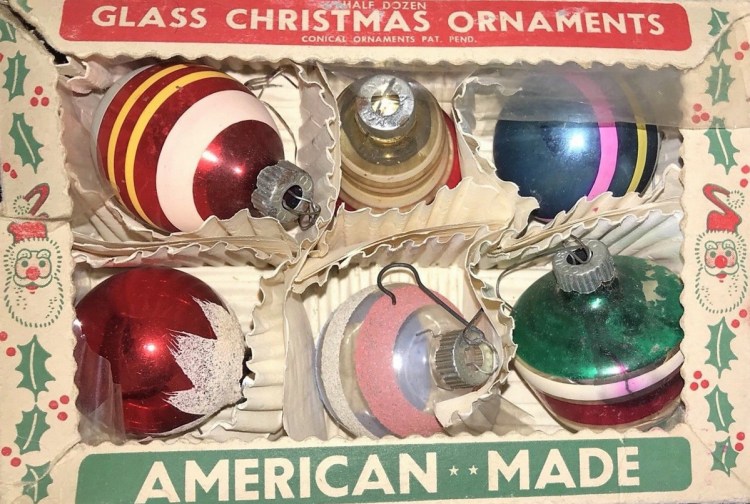LEWISTON — For more than a decade starting in 1959, a Lewiston factory looked something like a Christmas workshop as it churned out millions of brightly colored ornaments.
Paragon Glass Works, one of the first companies to move into the city’s industrial park, produced an astonishing array of glass balls.
Many of them were pretty plain, just colored globes sold for prices that show it’s been a while – as little as 29 cents for half a dozen big ones, 19 cents for a dozen little ones.
Now sought after by Christmas-crazed collectors, they’re widely available on eBay and Etsy at prices that make it clear America missed a chance to make a small fortune simply by socking some away in the attic.
Those little cardboard boxes – which cost about $2.50 in today’s inflated currency – now sell for as much as $50 apiece, depending on their size and condition.
Some are in teardrop shapes, some carry stenciled scenes. The fancier they look, the more they generally cost.
Consider one box of half a dozen conical glass ornaments produced at least a half century ago at Paragon’s Westminster Drive factory: In a box decorated with drawings of ivy and Santa – which saved its largest lettering for “American Made” – there are, among others, a red glass ball with yellow and white stripes, a blue ball with a purple and yellow stripe and a silvery one with a pink and a white stripe.

These glass Christmas ornaments were made by Lewiston’s Paragon Glass Works a half-century ago.
Paragon competed with larger manufacturers in Germany, Poland and beyond and, for a time, it was among the bigger glass ornament producers in the United States.
Ernest Paione, an owner of the glassworks, said that early on, foreign competition was tough, but he had faith his company could flourish because ornaments made elsewhere “lacked durability.”
By the mid-1970s, though, it couldn’t compete with the prices from a growing Christmas industry in Asia, especially with the market for its own products diminishing in America as a fickle public turned away from the seemingly old-fashioned glass balls in favor of the newest and latest.
At that point, Paragon managed to find a new niche, making ever more glass bulbs for automobile headlights and other items that appeared to have a more solid future than holiday decorations.
Even so, the company closed its doors in 2004, unable to match the prices of overseas competitors.
During its Christmas ornament heyday, though, Paragon made its mark.
When the company opted to move from New Jersey, it was big news. Even The New York Times noted it when the deal was announced in 1958.
The first shipment out from the new factory came in June 1959. It proved such a success that the plant expanded at least twice, in 1962 and 1966.
In December 1959, after its initial 40,000-square-foot factory was up and running, Paragon held a big dinner at the old DeWitt hotel in downtown Lewiston to thank Lewiston and state leaders for their hospitality in making its move possible.
Among those in high spirits that night was Gov. Clinton Clauson, a Waterville chiropractor-turned-politician. The 65-year-old Democrat, still in his first year in office, returned to the Blaine House that night and died in his sleep.
The following year, Maine honored what it called its Millionth Visitor in a bid to bolster its growing tourism trade.
Among the items handed over to the lucky visitor, Eric Leighton of Three Rivers, Quebec, was a key to the city of Lewiston and a box of Christmas tree ornaments from Paione.
In 1967, when a unit in Vietnam wrote to the governor asking if Maine could spare a pine tree so its Christmas could feel like home, Paragon sent along a big box of ornaments with a 9-foot tree that Gov. Kenneth Curtis shipped over to the troops.
One of the women on the receiving end, Ida Colford, later recorded in a book of her experiences that only three of the ornaments arrived broken.
Seeing the fully decorated Maine tree in Saigon, Colford recalled in an account published in “Women Vietnam Veterans: Our Untold Stories,” “My joy was uncontrollable.”
scollins@sunjournal.com
Send questions/comments to the editors.


